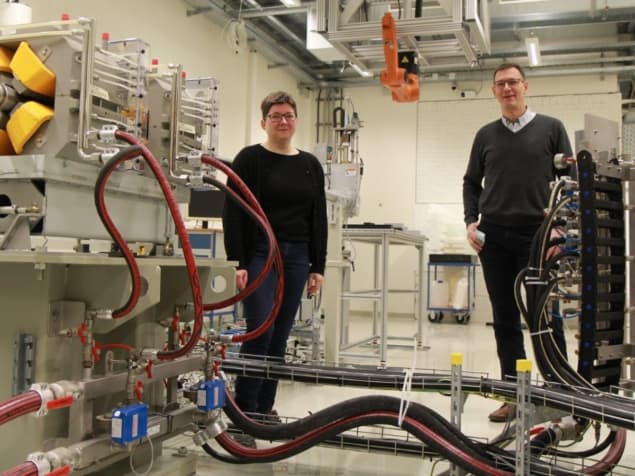
Radiotherapy using rapid irradiation at high dose rates, known as FLASH, could be used to protect healthy tissues during cancer treatments. Studies in animals have shown that electron irradiation with dose rates above 40 Gy/s reduces normal tissue damage while maintaining the tumour control seen at clinical dose rates (around 2 Gy/min). Meanwhile, the first clinical trials of FLASH radiotherapy are now starting to launch.
The mechanism behind this FLASH effect, however, remains unknown.
One popular theory proposed to explain the FLASH effect is that depletion of oxygen during irradiation creates a temporary hypoxic environment for both healthy and cancer cells. Hypoxic cells are 2–3 times more resistant to radiation than oxygenated cells. And as many cancers are already hypoxic (while healthy tissue is fully oxygenated), FLASH irradiation could provide a protective effect for healthy tissue without impacting the response of cancer cells.
The oxygen depletion is caused by radiolysis of water molecules, a process that creates reactive radicals that then react with oxygen molecules in the tissue. While simulations of such radiolysis processes have been published, there’s a lack of measurement data and systems that can evaluate oxygen consumption. To address these shortfalls, researchers in Germany have experimentally investigated radiolysis-induced oxygen consumption as a potential FLASH mechanism, publishing their findings in Medical Physics.
“We decided to measure the amount of oxygen being consumed by radiation with our oxygen sensors,” says first author Jeannette Jansen, a PhD student in Joao Seco’s group at the German Cancer Research Center (DKFZ). “The focus of the study was to quantify directly the amount of oxygen being removed by FLASH for different amounts of delivered dose.”
Irradiation investigations
Jansen, Seco and collaborators monitored oxygen consumption during FLASH irradiation of cylindrical water phantoms, using water with initial oxygen concentrations of between 0% and 21% atm (the concentration expected for water in contact with air containing 21% oxygen).

The team irradiated the phantoms with several radiation types at different dose rates: 225 kV photons at dose rates up to 52 Gy/s; 400 and 150 MeV/u carbon ions at dose rates up to 9.5 Gy/s; and 224 MeV protons at dose rates up to 340 Gy/s. Carbon ion irradiations were performed at the Heidelberg Ion Beam Therapy Center and proton irradiations at OncoRay Dresden.
The researchers employed TROXSP5 optical sensors to noninvasively measure changes in oxygenation during irradiation. They saw that oxygen levels in the water phantoms reduced linearly with increasing time and dose, and that the consumption rate was independent of the initial oxygen concentration.
The dose rate, however, did affect the rate of oxygen consumption, as well as impacting the dose level required for total depletion. Plotting the amount of oxygen removed per unit dose versus dose rate revealed a nonlinear relationship, with higher dose rates leading to less oxygen consumption for all radiation types.
The amount of oxygen consumed during irradiation was also dependent upon the particle type. For 10 Gy dose delivery, the oxygen consumption was 0.04–0.18% atm for photons, 0.04–0.25% atm for protons, and 0.09–0.17% atm for carbon ions, depending upon on the dose rate.
Oxygen is not to blame
For a phantom filled with water with an initial oxygen concentration of 2% atm, and assuming linear oxygen depletion (as observed in the measured data), the team calculated that 10 Gy radiation cannot deplete oxygen completely in water, for any of the radiation types or dose rates studied. At higher dose rates, 10 Gy irradiation could not reduce the oxygen concentration below 1.75% atm, which is not low enough to induce radioresistance.
“As indicated by the oxygen enhancement ratio, cells must become hypoxic for the protective effect of FLASH to occur,” explains Jansen. “Therefore, the residual amount of oxygen should be less than 0.5% atm to allow a factor of two decrease in oxygen-based damage.”
The team attributes this reduced oxygen consumption seen at higher dose rates to the lower numbers of reactive radicals available to react with oxygen. Although higher dose rates produce more radicals, suggesting that this would lead to higher oxygen consumption, many radicals are instead removed via self-interactions.
For example, the researchers calculated that solvated electrons (free electrons in solution) can diffuse far enough to interact with each other. Such radical recombinations actually lead to radicals being removed faster at higher dose rate. And at FLASH dose rates, this results in a lower steady state of radicals and reduced oxygen consumption – as observed in the experiments.

FLASH radiotherapy mechanism may arise from immune cell sparing
The researchers conclude that while FLASH irradiation does consume oxygen, their results imply that oxygen depletion alone is not a suitable mechanism to explain the FLASH effect.
“At clinical radiation doses, not enough oxygen is depleted to make a great difference in the resulting oxygen level in the cell, at least not enough to explain a difference in survival,” says Jansen. “And according to our results, less oxygen is depleted for higher dose rates, which is contradictory to what was postulated before.”
“We are currently investigating the FLASH effect in vitro, to test other mechanisms besides oxygen depletion that could explain the FLASH effect,” senior author Seco tells Physics World.
"Flash" - Google News
May 17, 2021 at 05:01PM
https://ift.tt/2Qr96u0
FLASH radiotherapy: oxygen depletion is not the sole cause – Physics World - Medical Physics Web
"Flash" - Google News
https://ift.tt/39L7UpV
Shoes Man Tutorial
Pos News Update
Meme Update
Korean Entertainment News
Japan News Update
Bagikan Berita Ini














0 Response to "FLASH radiotherapy: oxygen depletion is not the sole cause – Physics World - Medical Physics Web"
Post a Comment